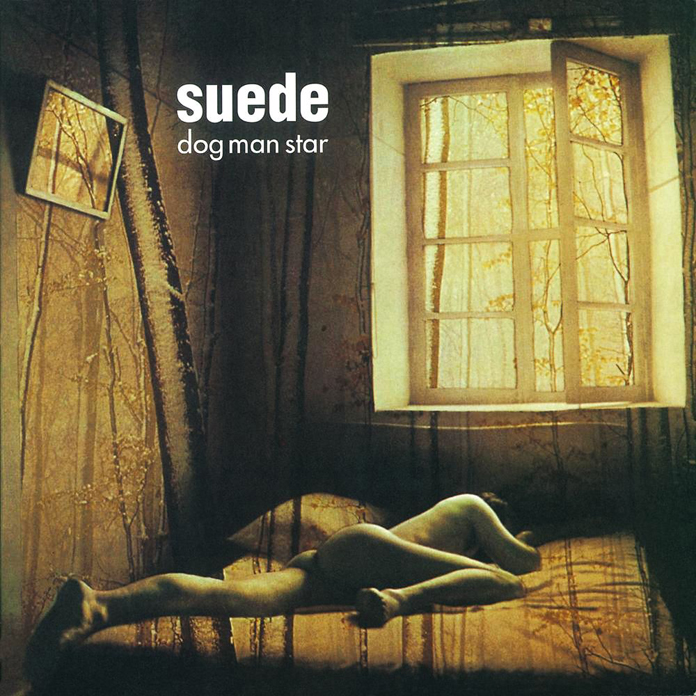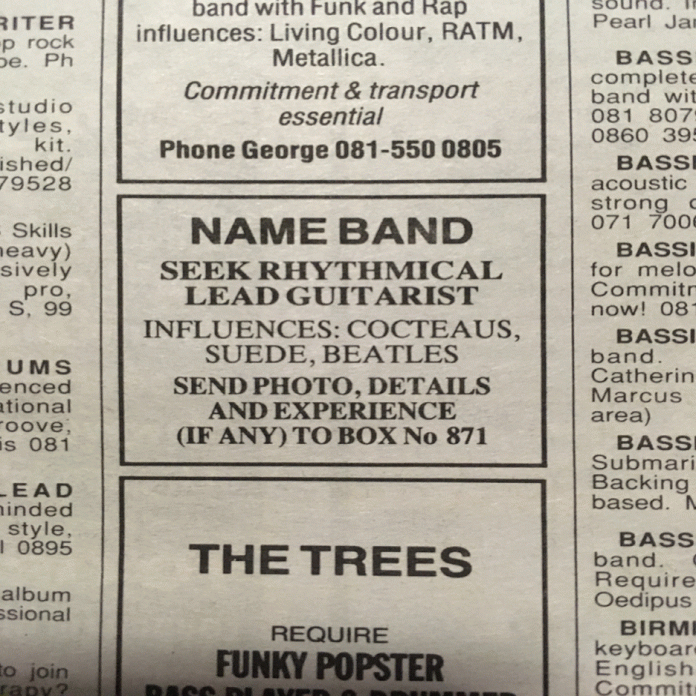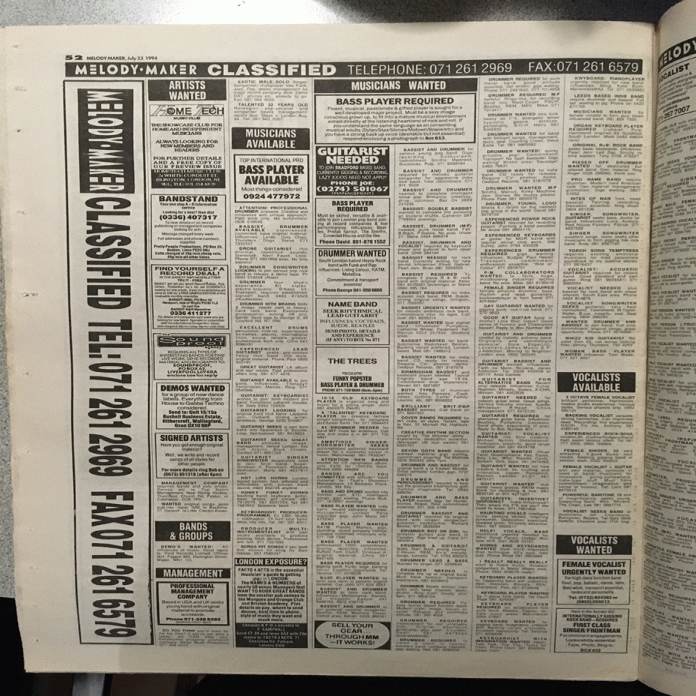
Suede – Reflecting on the 25th Anniversary of “Dog Man Star”
The Britpop Classic Was Released on October 10, 1994
Oct 10, 2019
Suede
![]()
Choice opportunities awaited aspiring rockers across Britain in the back of the music weeklies in the summer of 1994. Take the July 23rd issue of Melody Maker, for instance. There in the classifieds, a small but eye-catching box in the middle of page 52 called out for a drummer with “Funk and Rap influences: Living Colour, RATM, Metallica.” Commitment and transport were “essential,” presumably because this “South London based Heavy Rock band” were not yet operating at the level of the groups they name-checked.
Directly below that was a similar but significantly different ad. “Name Band seek rhythmical lead guitarist. Influences: Cocteaus, Suede, Beatles. Send photo, details and experience (if any) to Box 871.” Notably more humble in its demands (setting the barrier to entry at “any” experience), it also held the potential for a much greater reward. The “name band” who placed the ad wasn’t as big as The Beatles, but they were as big as Suede. Indeed, they were Suede.
Sending up a flare in the classifieds wasn’t a gimmick; or, at least, it wasn’t all a gimmick. True, Suede’s public search for a new lead guitarist following the abrupt departure of Bernard Butler did generate a lot of press coverage. The fact that auditions were practically open to the general musician population, and not just limited to the band’s own established connections, must have inspired some good will amongst their fan base. Suede were media savvy enough to know what they were doing in that regard. In the end, though, they didn’t pick a professional, they picked a 17-year-old from a seaside town called Poole who had mailed their fan club a demo tape.
In a way, choosing a pretty young thing to be frontman Brett Anderson’s new songwriting partner gave the impression of a classic rebound relationship. But the boy, Richard Oakes, could really play, and already had Butler’s licks down. Then it turned out he could write his own, too. Then Suede brought in a skinny keyboardist named Neil Codling, younger cousin of drummer Simon Gilbert, and suddenly the potential burnouts were brimming with pinups. In 1996 they came back with Coming Up, becoming more popular—across Europe and Asia, if not the U.S.—than ever.


Back in that summer of 1994, though, the remaining members of Suede had their backs against the wall whether or not they were willing to admit it. What might have happened if fate hadn’t sent them the right guitarist in their hour of need? What’s more, while Butler’s exit from the band had come after too many disputes in the studio recording their second album, most if not all of his share of the work was finished. Dog Man Star, the follow up to their self-titled glam rock resuscitating debut, could have easily been their Smile, a near-mythical lost classic to be at best pieced together or approximated in future releases.
Some have claimed that there are in fact still empty spaces throughout the final Dog Man Star that Butler left behind which were never filled in. This opinion might not be giving Suede enough credit, that perhaps those songs were given more space on purpose. Anderson himself hasn’t expressed any regret about not cluttering up the recording tapes, but on the album’s 2011 reissue he did give into the foul temptation to imagine an alternate version of the track list. “Listening back to all this stuff makes me want to re-write history. If I could do it all again I’d do it slightly differently,” he writes.
Anderson’s updated Dog Man Star flips “New Generation” and “This Hollywood Life” but otherwise the running order of what he keeps stays mostly the same. He does extract two of the deeper cuts, “The Power” and “Black or Blue,” in order to insert three non-album tracks from that era, and those seem to be telling choices. “The Power” is the only song on the album that Butler doesn’t play on. When it came to finishing “Black or Blue,” the story goes that Butler had to be ordered by force of his contract back into the studio to complete his parts.
One can see why, after everything that happened back then and everything that has transpired since, Anderson would want to swap in a few fan-favorite B-sides for the two songs shaped the most by Butler’s departure. On the other hand, Dog Man Star with the punching riffs of “Killing of a Flashboy” instead of the lush space oddity of “The Power” and the cold, lonely falsetto of “Black or Blue” becomes a different beast from the one Anderson was there to help celebrate with that reissue in the first place. Band biographer David Barnett is correct when he writes that “The Power” comes as a “welcome breath of light relief” on the album after the dark distant dream of “Daddy’s Speeding.” The middle eight of “The Power” features a muffled sample where Butler would have surely shown off, but lacking a demonstration of virtuosity actually helps the song to stand out on the album.
Butler gets all the time he needs on the nine-and-a-half minutes of the penultimate “The Asphalt World,” which probably would have run a few minutes longer if he had hung around long enough to be there for final edits. “The Asphalt World” has its own spaced-out breakdown in the middle stretch, a necessary breather before it all comes crashing back in for the final lap. “The Asphalt World” is the kind of song that might inspire some to say “They don’t make ‘em like they used to.” They do still make ‘em like “The Asphalt World,” but the commercial stakes usually aren’t as high because the groups that make ‘em like this aren’t mainstream acts in the way that Suede were in the UK in 1994. Even in the U.S., where the band’s momentum had purportedly stalled early, their 1993-released debut album Suede sold in the ballpark of 150,000 copies, which feels something like quadruple platinum by today’s sales standards.

(Suede in 2018, photo by Dean Chalkley)
That is a real difference between then and now. A record like Dog Man Star could still be made today, but at most it would be camped at the outskirts of the pop realm that Suede back then called home. Suede themselves—an ongoing contemporary concern with three quality albums to their name this decade—rediscovered their experimental spark on last year’s The Blue Hour, but they did so with the knowledge that such indulgences are less risky when an appearance on Top of the Pops isn’t at stake anymore. In 1994 it definitely was, and Suede made Dog Man Star anyway.
An almost disproportionate number of great albums were released in 1994, many of which are now rightly considered classics, but not every member of that class truly pushed creative boundaries. Definitely Maybe was an unbeatable rock and roll escape, but some music writers were reaching when they painted the way Oasis stood stock still on stage as some kind of revolutionary posture. Blur’s Parklife was practically flawless, but the sense of irony baked into the album relieved it from having to answer for anything. That goes double for records like Green Day’s Dookie and Beck’s Mellow Gold.
Dog Man Star was high strung with a theatrical flair that lifted it out of the sternness of records like Nine Inch Nails’ The Downward Spiral and Soundgarden’s Superunknown, the downer side of rock’s coin that year. That’s not to say Suede weren’t entirely serious about their art. They knew from the outset what they wanted to do with their sophomore LP. Anderson intentionally moved out of his airy bohemian apartment in Notting Hill (the neighborhood back then still had some of its funky edge left) and found a more separated and subterranean dwelling to get himself in the right, or wrong, frame of mind. Perhaps a little too much has been made of the basement apartment of this remote gothic mansion full of singing Mennonites upstairs to which Anderson had vanquished himself to (if you look the place up on Google maps, it appears to be a perfectly nice, normal London neighborhood), but you can’t question the commitment to his craft.
What hallucinatory dramas did Anderson conjure up from his chemical nights and curtained days? Apocalyptic social upheaval, fiery car crashes, tragic beauties and beautiful tragedies, and interestingly, in both “The 2 of Us” and “Still Life,” the plight of well-kept but lonely housewives. In those songs and others such as “The Power,” Anderson explores the depths of what Pink Floyd had previously pointed out 20 years before in “Time” from Dark Side of the Moon: “Hanging on in quiet desperation is the English way.” Dog Man Star wanted to take that bottled angst, stick a rag down its neck, light it up, and let it all out.
Suede had authored a major statement about the world as they saw it, but the timing of Butler’s departure meant that the band’s own internal issues were frequently read into it. Anderson was aware that this would be the case well before the record hit the shops. “The only thing that bothers me is that Bernard leaving is going to become the hype issue of this album…. Everyone will analyse it in the light of our guitarist quitting which will deflect from the content of the album,” he told the New Musical Express a month before Dog Man Star‘s release, in a cover interview that did everything it could to paint Anderson, Gilbert, and bassist Mat Osman in the most confident, optimistic light.
Osman went as far as to say it would be good to get someone new in the band because he felt that certain Suede ideas had been pushed to the limit. “Songs like ‘The Asphalt World’ and ‘This Hollywood Life’ have gone about as far as they can go without becoming one-upmanship,” he said. “That’s why I find it very hard to imagine, even if Bernard had stayed, what the next album would have been like without it being beautiful and impotent. This album states the case for Suede far more clearly than the last one….” Suede had Oakes learn all the parts so they could keep playing the Dog Man Star songs, but they didn’t even attempt to write more in that vein. Their autumn-hued album sleeves turned neon, and so did their sound. Instead of wringing out lyrics like “The snow might fall and write the lines on the silent page/But you’re outside making permanent love to the nuclear age,” Anderson started rhyming “film star” with “bar” and “car,” and sounded like he was having great fun doing so.
Coming Up was embraced by a Cool Britannia still on the rise, whereas two years prior Dog Man Star had been critically hailed but also criticized by some for being out of step with the burgeoning Britpop scene they were supposedly in part responsible for. Nowadays, you couldn’t fault someone for claiming that any one of their first three albums is their best work (though if anyone argues for Head Music they’re helpless), but Anderson’s mission to make an album of 10 pop singles wouldn’t have been a novel idea if it hadn’t been a direct result of the draining creation of Dog Man Star. Suede were nothing if not a deeply self-conscious band, and they knew as well as anyone that all the hip shaking and glam titillation could only take them so far. They put it all out there on Dog Man Star, and the results still pay off.
www.suede.co.uk
www.twitter.com/suedeHQ
www.facebook.com/SuedeOfficial/
Support Under the Radar on Patreon.
Current Issue

Issue #72
Apr 19, 2024 Issue #72 - The ‘90s Issue with The Cardigans and Thurston Moore
Most Recent
- Margaret Glaspy Announces New EP, Shares Video for New Song “24/7” (News) — Margaret Glaspy
- Premiere: ÖZLEM Shares New Video for “DURANGO” (News) — ÖZLEM
- Mitski Shares a New Video for “Star” (News) — Mitski
- Waiting in the Sky (Before the Starman Came to Earth) (Review) — David Bowie
- Challengers (Review) —

Comments
Submit your comment
There are no comments for this entry yet.